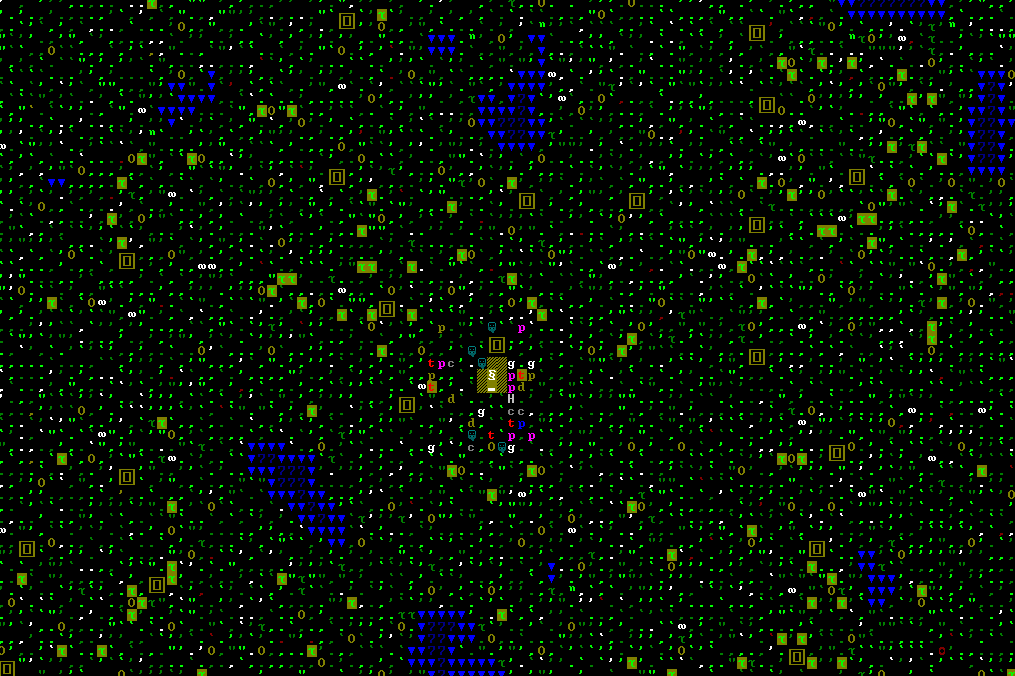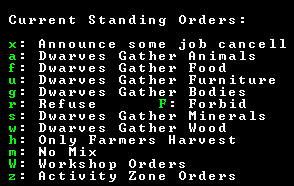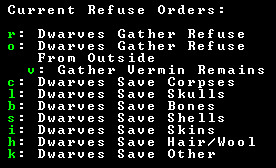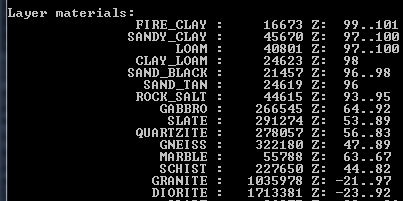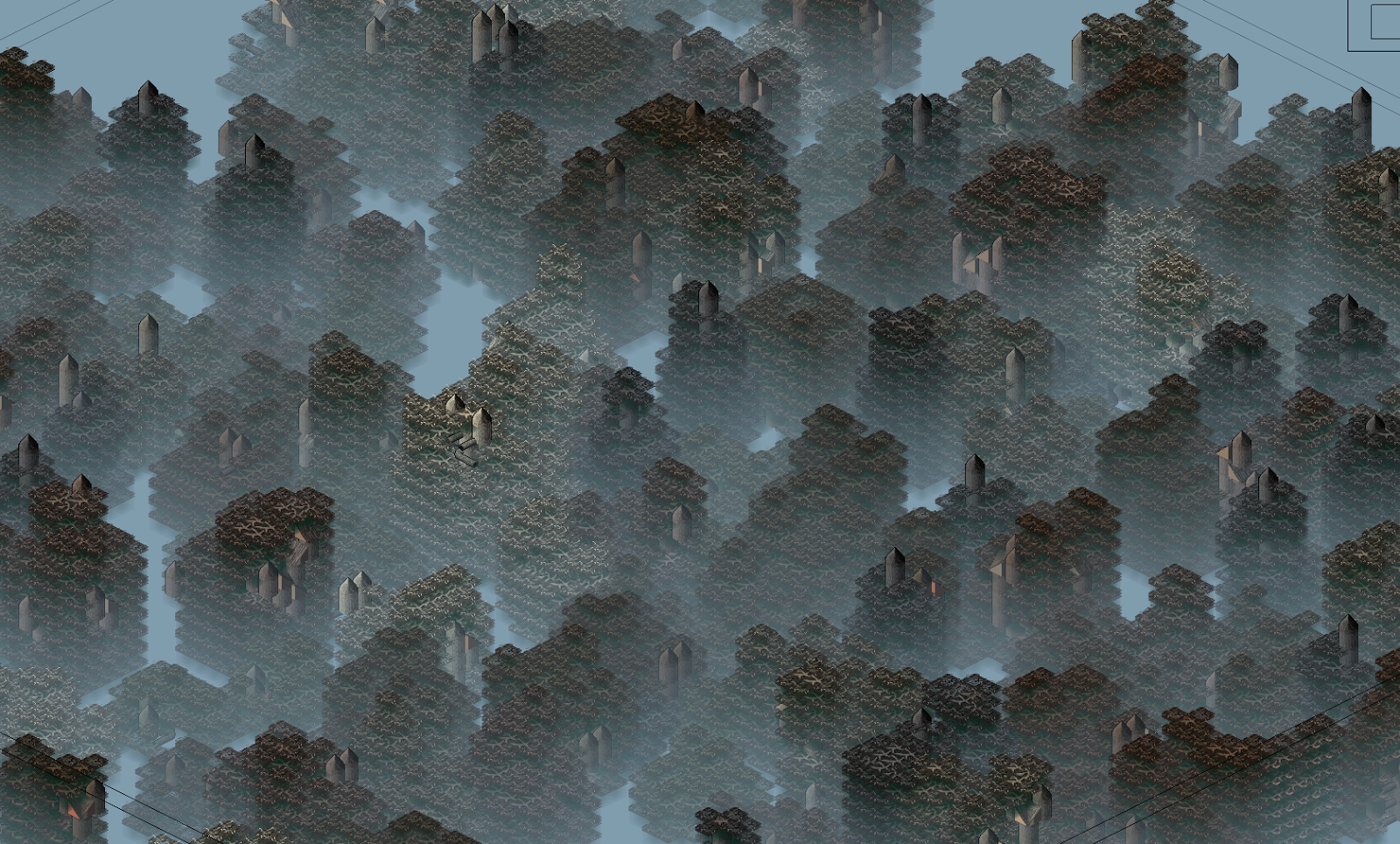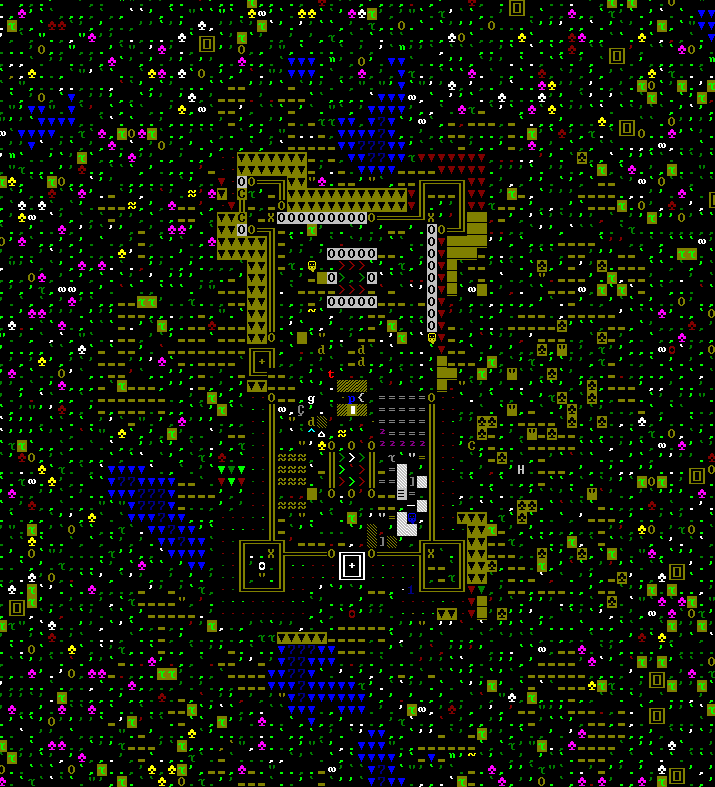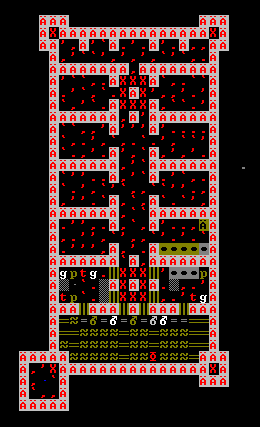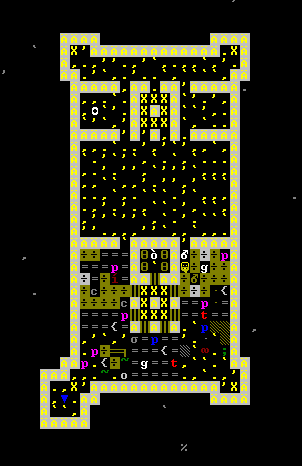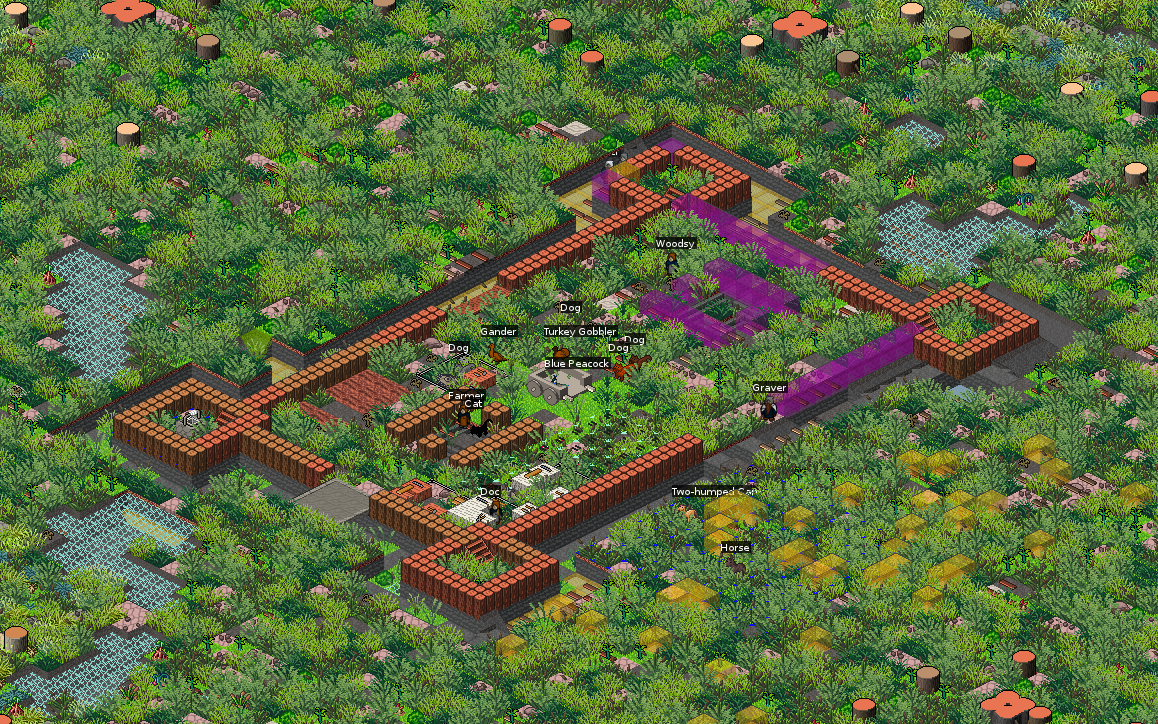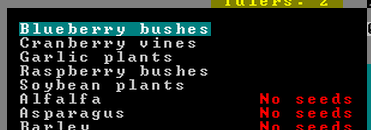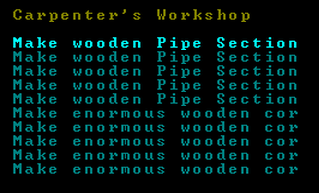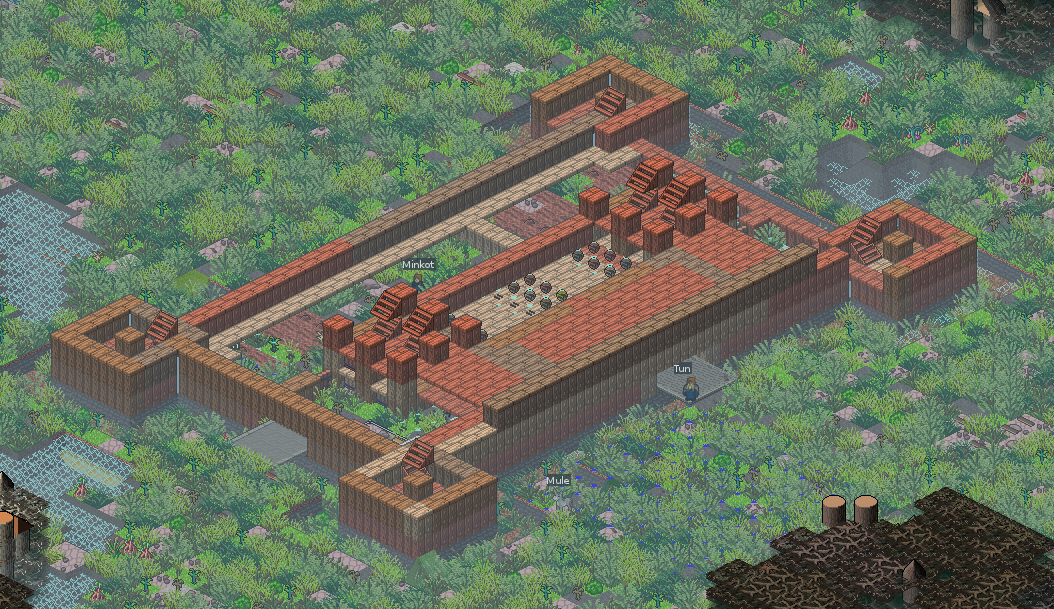DF2014: Gusilsazir (Copperbridge) Year 400 - Embark and Strike the Earth!
by Wuphon's Reach
No wildlife is visible and the land is very flat with many large trees.
First rule of survival, make sure the cook doesn't use up our seeds making meals. Or cook all of our alcohol into meals.
Secondly, we set orders. The first is (o) and (h) so that only farmers with the proper labor do plant harvesting, the second is (o) and (m) to prevent things from being mixed in barrels.
Followed by (o)(F)(i) which forbids items when someone dies (such as their socks) and (o)(F)(o) which prevents dwarves from running out to take dead bodies to the coffins.
Third, setting the refuse options (o)(r)(o) make them gather outside refuse and (v) to also gather vermin remains from inside/outside the fort. This also affects garbage dump zones in DF2014, even the dumping of things which are inside the fort.
Lastly we only allow fishing (o)(z)(f) at specified zones and drinking is only allowed at the defined zones (o)(z)(d).
That should keep the dwarves out of immediate trouble.
Looking at the civilization menu, there are actually some people listed in the menu for Ropes of Work (no other civs are listed, because we are isolated on an island).
Fun fact... most of those names are goblins. There are a few exceptions such as the dwarf Arstruk Prairiemonster, administrator in Bellsscorch.
DFHack "prospect all" tells us that we have marble for sure and that there is Iron, Silver and Copper ores on this location.
Interestingly, the surface is at Z+100, but the magma sea is at Z-17 to Z-23, so this will be the first embark where I've had negative Z numbers to deal with. Still, that means it is about 120 levels to get to the magma.
A look at the trees reveals that there are no trees above Z+18 in the underground. The three caverns are likely mashed together at the very bottom of the embark area.
Underground crops look like they might be difficult to do since sand/clay/loam are in Z 96-101 and the aquifer is in Z 96-99.
The trees are extra thick. Looking at the area in stonesense reveals how thick. There are dwarves in the picture, honest... I should have brought a second battle axe instead of a second pick.
Stonesense reports that the Z100 surface level is +130 in Stonesense, a quick check for the tops of the caverns puts the very top at Z20. With no trees appearing before Z+18 as reported by DFHack.
First things to attend to:
- Collect the surface plants.
- Setup surface crops in farm plots.
- Cut down trees in the immediate area.
- Start digging stairs to see where the aquifer really is.
- Get a wooden stockade wall up around the wagon.
- Setup nest boxes for the birds (craft workshop)
- Get the livestock penned up.
- Construct surface buildings for the moment with stockpiles inside.
- Create a carpenter's workshop for beds, doors, tables, chairs, pumps, trap components.
- Build a well over an aquifer hole and see if we get fresh water to drink.
Initial labor assignments:
Turns out that in this area, the aquifer has three layers of soil above it. Given how DF2014 works with tree roots, that means I can dig out my sub-surface farms and initial rooms on the Z98 layer, with Z99 acting as a buffer. If I put buildings or roads on Z100 above any sub-surface farms, it's possible that those farms would be okay.
Trying to keep cave adaption at bay is going to be difficult as well. Normally I would dig a huge hole in the ground, cover it over with constructed floors and then have activity zones in those sunlit areas. But with the aquifer, I will have to rethink that strategy.
1st Hematite (start of summer), work on the temporary walls, lodgings, underground farms and such is about 80% done. Plans have been drawn up for three bridges on the east/west/south sides.
Z100 is the surface, Z99 is the buffer level, and Z98 is the first layer with buildings. Right now, Z98 is dedicated to the farms on the south end, plus a bunch of temporary rooms for workshops running up the main corridor. Due to uncertain conditions, all workshops are being designed so they can be easily sealed off in the case of failed strange moods.
On Z97, I have prepared pastures for the pigs, a few tiny rooms, but most of the area is dedicated to the aquifer piercing project that will start next month. I took advantage of the aquifer layer on Z96, dug a channel down into it, and put a well on it (west of the northern stairs).
One of the minor mistakes that I made when embarking in an area with an aquifer was to only bring (10) stones. That limits me to only (10) mechanisms until I manage to pierce the aquifer and get below it to harvest more stone. Fortunately, I also brought (10) stone block for things like wells or bridges which needed to be fireproof, but bringing 15-20 would not have been a bad idea.
None of the surface crops are yet in a farm plot. I have to figure out how to process them in a way that produces seeds (probably at a farmer's workshop). We would be on the way to starving except for the fortune that put the aquifer under three layers of soil.
A forest fire would wipe us right out at the moment, with all of the doors being made of wood, as well as the bridges and walls of the surface. The underground stockpiles might survive, unless some on-fire dwarf spreads the fire underground.
All of the (9) female egg laying birds are currently pastured in 1x1 zones on top of nest boxes. All of them have laid and we are waiting for hatching to commence. Once they hatch, the young will be stuffed into cages scattered around until they grow up. I will also create an egg stockpile to gather the next batch of eggs and use it for cooking.
The goal for the four corners of the surface fort is to build a 3-4z tall tower which can be used by marksdwarves to shoot at enemies outside the dry moat. They will come up from below into a sealed tower with no other exit.
Wildlife ('u' menu, 'others') has been tame so far. We have seen geese, ravens, and a few other benign animals.
The tentative goals for summer are:
- Finish the dry moat, the three bridges and hook them up to the only lever.
- Drain that north pond into the dry moat so that it evaporates.
- Collect all of the logged wood and get it into a stockpile.
- Start producing the half dozen pump parts which will be needed for piercing the aquifer.
- Create prepared meals and booze (need barrels).
- Collect and process surface plants in hopes of starting surface farms.
- Dig a few test staircases to see if the aquifer is everywhere.
We have no mechanisms to be used in traps, so the only reason that I am making spiked wooden balls at the moment is the off-chance of a dwarven caravan in the Autumn season.
Piercing of the aquifer will start in mid-late summer at this rate. Establishment of food and booze sources was more of a priority. Plus it is possible that this is a temperate biome and things will freeze in the winter. That could make it faster to pierce the aquifer. First piercing method will remain the dual-slit method with a single pump (and pumper) per level from within the fort. If I see things freeze come winter, then I will prep for a larger scale piercing project in the second winter (a hole big enough for that 11x11 skylight area).
8th Malachite - WE GOT MIGRANTS! Praise Armok!
9th Malachite - Oh dear, Armok has sent us 8 migrants, doubling our population overnight. This is going to involve a bit of fun and will strain our stockpiles. Especially since we have not yet dug down into the rock layers.
22nd Galena - Due to the influx of migrants, we have butchered the draft animals and produced many biscuits. The cook, however, decided to also raid the eggs in the nest boxes which were waiting to hatch. I caught it after a few of the nest boxes had been disturbed, but a few of the nest boxes were still okay. So the bird-hatching program has only suffered a minor setback and not a complete disaster.
Note to self: Next time, lock the door to the nesting room.
Have also started building upwards using all the wooden logs that we have laying around. The dining room is going to be on the second floor of the courtyard area.
I now have a dwarf working in the Farmer's Workshop, threshing any possible plants, as well as "process root", "process plants" and "process fruiting plant" all on repeat until they run out of work. That gave me strawberry seeds, blueberry seeds, raspberry seeds, and soybeans to be planted in the surface crops. Looking at the list, I also now have garlic plants listed as something I can plant.
Construction starts soon on the five pipe sections and five wooden corkscrews that we will need for the pumps.
13th Limestone - The following message pops up.
So, we're going to get a caravan this year, but no outpost liaison. Which makes sense on the liaison since all of the dwarven sites for Ropes of Work have been destroyed or taken over.
21st Limestone - Finished trading, picked up a few things but not much.
Going to let the cook use up all of the eggs, then I will lock the door to the nesting room again. Nothing had hatched yet, even though we have new piglets, puppies and kittens elsewhere. All of the piglets, puppies and kittens have been stuffed into a cage to keep them from being underfoot. I will let them out when they grow up in a few months.
The farm plots in the northwest corner of the courtyard are now dedicated to growing blueberries (8), blackberries (5), and raspberries (5). Those plants get processed at a farmer's workshop (process fruiting plant) into berries and seeds at which point the berries get brewed (brew drink from fruit).
7th Standstone - Peachicks, two batches of goslings and two batches of poults have finally hatched. Six new migrants have arrived bringing us to 23 total dwarves. Construction has started on the second floor dining hall.
13th Timber - Surface fortifications are coming along nicely, shame that it is all built out of wood logs and not stone blocks.
All full-grown grazers have been butchered and processed at the slaughterhouse.
This is a pretty standard layout. The butcher workshop is in the middle, tannery to the south and kitchen to the north. The tannery and kitchen are not linked to any stockpiles, so they can pull from anywhere in the fort. The kitchen is only used for rendering fat into tallow.
Note the use of multiple doors. That way, if something rots, the miasma will be self-contained. In the case of the butcher, it also keeps dwarves from getting bad thoughts about seeing an animal being butchered. But mostly it's to prevent the spread of miasma if you can't keep your butcher shop above ground.
If you are doing a lot of butchering, it can be a good idea to setup stockpiles to pull from the butcher, just to get the clutter out of the shop and into stockpiles where it won't rot right away. I'll generally setup a refuse stockpile which only allows Fresh Raw Hide by the tannery, and a food stockpile by the kitchen which holds fat. That way, workers will immediately move fresh hides and fat out to stockpiles instead of letting it fester in the butcher shop. There is no need to configure those two stockpiles to pull from the butcher workshop. Just having them nearby will result in fat/hides being pulled quickly out of the butcher's workshop.
It may also be good to setup a 5x5 (up to 4x8 or 5x8) stockpile with no barrels right next to the butcher's workshop (in an adjacent room) which holds raw meats but uses zero barrels. That way, workers can pull the meats out of the butcher's workshop and park it somewhere quickly. Then you can have another stockpile pull from that one and consolidate into barrels. That initial stockpile is typically set to pull only from links (linked to the butcher) - which prevents it from being filled up by other sources of raw meat.
If you have hunters, setting up a small 2x2 or 3x3 refuse pile that allows fresh corpses can be useful. If the refuse pile is close enough to the butcher and "Auto Butcher" is turned on in the (o) orders / (W) workshop menu, the butcher will automatically process any corpses in that refuse pile. There's no need for that stockpile to give to the butcher, proximity is enough.
If you need a kitchen with linked stockpiles for cooking up regular meals, the best approach is to setup a second kitchen somewhere else with the appropriate stockpiles around it. Leave the kitchen by the butcher alone so that automated fat rendering jobs work properly.
27th Timber - Starting to try and pierce the aquifer. Missing a few machine parts such as blocks for the screw pumps.
7th Moonstone - A weretortoise shows up! We have no militia yet, just a single crossbow and possibly zero bolts. Worse, he showed up near our gates.
Step one, define a "inside" burrow (the "w" menu). Paint it to include the three underground floors, plus the three above ground floors. Cut out areas where the surface bridges are installed.
Step two, use the military (m) menu to force civilians into the burrows. Do this by highlighting the current alert (called "Inactive" by default), arrow to the right and hit enter on the burrow that you just created. That should force all civs to drop everything and get within the burrow's boundaries.
Step three - pull the lever! The one hooked up to the gates of the fort, which I hope that I hooked up.
First loss - the mule foal that was pastured outside. Fortunately this meant that the gates had time to close before the weretortoise made it inside the gates.
A quick count of beards reveals that all dwarves are inside except for Adil Liddodok and Mafol Lolokokil. The werebeast is on the east side, while Adil is on the west side (dark blue dwarf). Mafol is on the south side of the fortress.
A quick check of Adil's relationships reveals no relatives. So if she doesn't survive, it's possible that the fort will not end in a tantrum spiral. Mafol does not have any relatives either.
In the meantime, dwarves inside the walls are busy turning bones into bolts.
Mafol begins fighting with the werebeast, dodging and jumping away, landing in the dry moat. This buys a brief retrieve as the beast mills about before finding a way to climb down safely. Mafol lasted a short while before his leg tendon was severed and he was no longer able to stand. After that it was over quickly.
Fortunately, before it got to Adil, it transformed back into a human.
I'll take a risk and order the bridges lowered in hopes that Adil can make it inside.
9th Moonstone - the werebeast has left the map. Time to build a tomb for Mafol and get him buried.
17th Moonstone - Looking at my farmer's workshop, there is a build-up of leaves inside it.
The only way to troubleshoot this is to dig into the raws directory and find the plant definition. In the case of blueberry and cranberry plants, this is the raws/objects/plant_garden.txt file.
What this tells us is that the leaves can be eaten by vermin, but are otherwise not edible. There are no material reactions either. So the only use for those leaves at the moment is to rot in a refuse pile. However, even if you have a refuse pile with leaves enabled, they won't get carted at the moment. The best choice (for now) is to designate them for dumping and have an outside garbage dump tile.
The rest of the winter was spent fighting with the aquifer layer, trying to get through it without drowning. That involved a lot of trial and error but I finally got a large pit opened up, big enough for a caravan ramp plus stairs.
Subscribe via RSS


